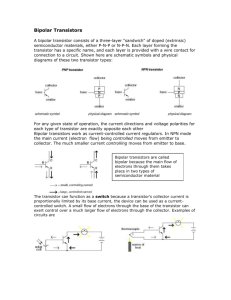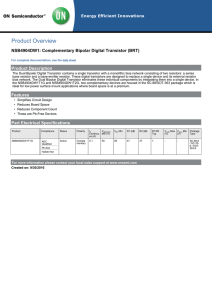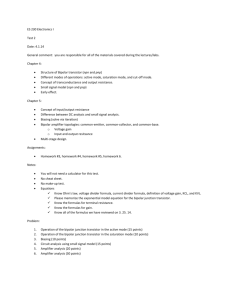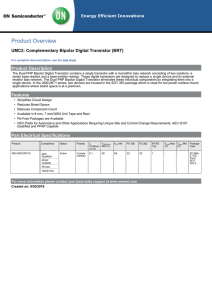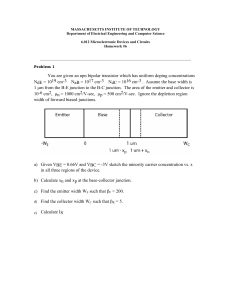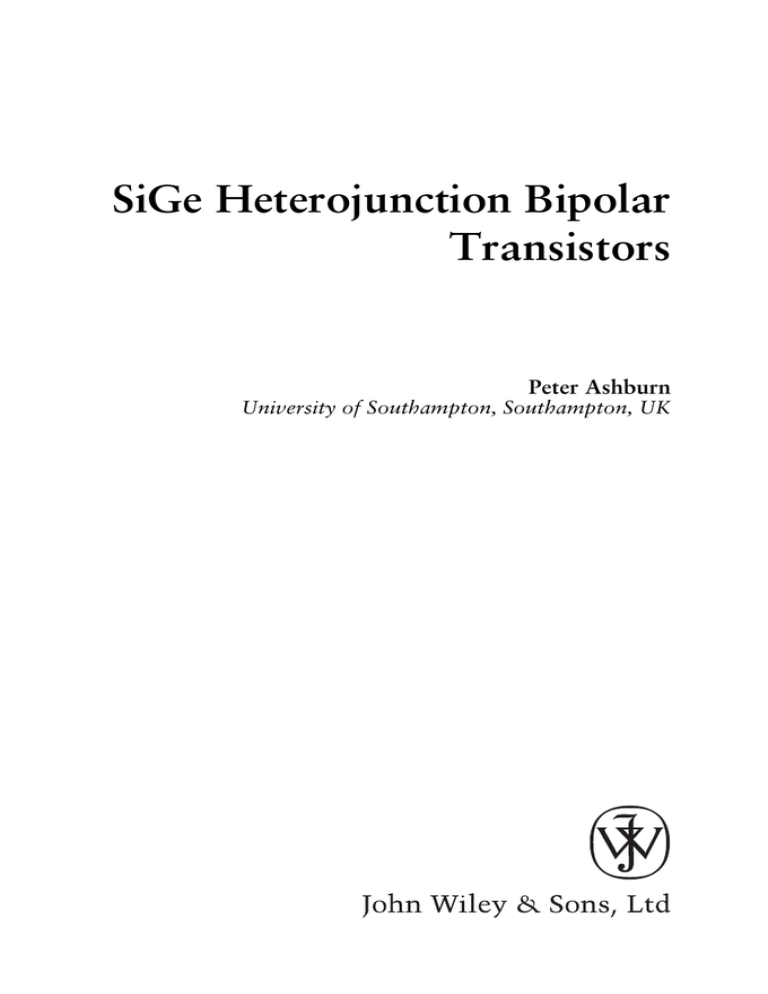
SiGe Heterojunction Bipolar
Transistors
Peter Ashburn
University of Southampton, Southampton, UK
SiGe Heterojunction Bipolar
Transistors
SiGe Heterojunction Bipolar
Transistors
Peter Ashburn
University of Southampton, Southampton, UK
Copyright 2003
John Wiley & Sons Ltd, The Atrium, Southern Gate, Chichester,
West Sussex PO19 8SQ, England
Telephone (+44) 1243 779777
Email (for orders and customer service enquiries): cs-books@wiley.co.uk
Visit our Home Page on www.wileyeurope.com or www.wiley.com
All Rights Reserved. No part of this publication may be reproduced, stored in a retrieval
system or transmitted in any form or by any means, electronic, mechanical, photocopying,
recording, scanning or otherwise, except under the terms of the Copyright, Designs and
Patents Act 1988 or under the terms of a licence issued by the Copyright Licensing Agency
Ltd, 90 Tottenham Court Road, London W1T 4LP, UK, without the permission in writing of
the Publisher. Requests to the Publisher should be addressed to the Permissions Department,
John Wiley & Sons Ltd, The Atrium, Southern Gate, Chichester, West Sussex PO19 8SQ,
England, or emailed to permreq@wiley.co.uk, or faxed to (+44) 1243 770620.
This publication is designed to provide accurate and authoritative information in regard to
the subject matter covered. It is sold on the understanding that the Publisher is not engaged in
rendering professional services. If professional advice or other expert assistance is required,
the services of a competent professional should be sought.
Other Wiley Editorial Offices
John Wiley & Sons Inc., 111 River Street, Hoboken, NJ 07030, USA
Jossey-Bass, 989 Market Street, San Francisco, CA 94103-1741, USA
Wiley-VCH Verlag GmbH, Boschstr. 12, D-69469 Weinheim, Germany
John Wiley & Sons Australia Ltd, 33 Park Road, Milton, Queensland 4064, Australia
John Wiley & Sons (Asia) Pte Ltd, 2 Clementi Loop #02-01, Jin Xing Distripark, Singapore
129809
John Wiley & Sons Canada Ltd, 22 Worcester Road, Etobicoke, Ontario, Canada M9W 1L1
Wiley also publishes its books in a variety of electronic formats. Some content that appears
in print may not be available in electronic books.
Library of Congress Cataloging-in-Publication Data
Ashburn, Peter.
SiGe heterojunction bipolar transistors / Peter Ashburn.
p. cm.
Includes bibliographical references and index.
ISBN 0-470-84838-3
1. Bipolar transistors. 2. Silicon. 3. Germanium. I. Title.
TK7871.96.B55A88 2003
621.3815 282 – dc22
2003049482
British Library Cataloguing in Publication Data
A catalogue record for this book is available from the British Library
ISBN 0-470-84838-3
Typeset in 10.5/13pt Sabon by Laserwords Private Limited, Chennai, India
Printed and bound in Great Britain by TJ International, Padstow, Cornwall
This book is printed on acid-free paper responsibly manufactured from sustainable forestry
in which at least two trees are planted for each one used for paper production.
To my wife, Ann, and daughters Jenny and
Susie
Contents
Preface
xiii
Physical Constants and Properties of Silicon and
Silicon-Germanium
xvii
List of Symbols
xix
1 Introduction
1.1 Evolution of Silicon Bipolar Technology
1.2 Evolution of Silicon-Germanium HBT Technology
1.3 Operating Principles of the Bipolar Transistor
References
1
1
3
5
10
2 Basic Bipolar Transistor Theory
2.1 Introduction
2.2 Components of Base Current
2.3 Fundamental Equations
2.3.1 Assumptions
2.4 Base Current
2.4.1 Base Current in Shallow Emitters
2.4.2 Base Current in Deep Emitters
2.4.3 Recombination Current in the Neutral Base
2.5 Collector Current
2.6 Current Gain
2.7 Gummel Numbers
13
13
13
16
17
19
20
21
22
23
24
25
3 Heavy Doping Effects
3.1 Introduction
3.2 Majority and Minority Carrier Mobility
27
27
28
viii
3.3
3.4
3.5
3.6
References
CONTENTS
Bandgap Narrowing
Minority Carrier Lifetime
Gain and Heavy Doping Effects
Non-uniform Doping Profiles
4 Second-Order Effects
4.1 Introduction
4.2 Low Current Gain
4.2.1 Recombination via Deep Levels
4.2.2 Recombination Current in the Forward
Biased Emitter/Base Depletion Region
4.2.3 Generation Current in a Reverse Biased pn
Junction
4.2.4 Origins of Deep Levels in Bipolar
Transistors
4.3 High Current Gain
4.4 Basewidth Modulation
4.5 Series Resistance
4.6 Junction Breakdown
4.6.1 Punch-through
4.6.2 Zener Breakdown
4.6.3 Avalanche Breakdown
4.6.4 Junction Breakdown in Practice
4.6.5 Common Base and Common Emitter
Breakdown Voltages
4.6.6 Trade-off between Gain and BV CEO
References
5 High-frequency Performance
5.1 Introduction
5.2 Forward Transit Time τF
5.2.1 Components of τF
5.2.2 Base Transit Time
5.2.3 Emitter Delay
5.2.4 Collector/Base Depletion Region Transit
Time
5.2.5 Emitter/Base Depletion Region Delay
5.3 Cut-off Frequency fT
5.4 Maximum Oscillation Frequency fmax
5.5 Kirk Effect
32
36
39
40
42
45
45
46
46
49
52
53
56
58
59
61
62
63
64
65
65
68
69
71
71
72
72
72
74
75
76
76
79
80
CONTENTS
5.6 Base, Collector and Emitter Resistance
5.6.1 Base Resistance
5.6.2 Collector Resistance
5.7 Emitter/Base and Collector/Base Depletion
Capacitance
5.8 Quasi-saturation
5.9 Current Crowding
References
6 Polysilicon Emitters
6.1 Introduction
6.2 Basic Fabrication and Operation of Polysilicon
Emitters
6.3 Diffusion in Polysilicon Emitters
6.4 Influence of the Polysilicon/Silicon Interface
6.5 Base Current in Polysilicon Emitters
6.6 Effective Surface Recombination Velocity
6.7 Emitter Resistance
6.8 Design of Practical Polysilicon Emitters
6.8.1 Break-up of the Interfacial Oxide Layer and
Epitaxial Regrowth
6.8.2 Epitaxially Regrown Emitters
6.8.3 Trade-off between Emitter Resistance and
Current Gain in Polysilicon Emitters
6.8.4 Emitter Plug Effect and in situ Doped
Polysilicon Emitters
6.9 pnp Polysilicon Emitters
References
7 Properties and Growth of Silicon-Germanium
7.1 Introduction
7.2 Materials Properties of Silicon-Germanium
7.2.1 Pseudomorphic Silicon-Germanium
7.2.2 Critical Thickness
7.2.3 Band Structure of Silicon-Germanium
7.3 Physical Properties of Silicon-Germanium
7.3.1 Dielectric Constant
7.3.2 Density of States
7.3.3 Apparent Bandgap Narrowing
7.3.4 Minority Carrier Hole Mobility
7.4 Basic Epitaxy Theory
ix
84
84
86
87
88
90
91
93
93
94
96
100
101
104
107
108
108
111
112
115
116
118
121
121
122
122
123
125
127
127
127
128
129
130
x
CONTENTS
7.4.1 Boundary Layer Model
7.4.2 Growth Modes
7.5 Low-Temperature Epitaxy
7.5.1 In situ Hydrogen Bake
7.5.2 Hydrogen Passivation
7.5.3 Ultra-clean Epitaxy Systems
7.6 Comparison of Silicon and Silicon-Germanium
Epitaxy
7.7 Selective Epitaxy
7.7.1 Faceting and Loading Effects
References
8 Silicon-Germanium Heterojunction Bipolar Transistors
8.1 Introduction
8.2 Bandgap Engineering
8.3 Collector Current, Base Current and Gain
Enhancement
8.4 Cut-off Frequency
8.5 Device Design Trade-offs in a SiGe HBT
8.6 Graded Germanium Profiles
8.6.1 Design Equations for a Graded Germanium
Profile
8.7 Boron Diffusion in SiGe HBTs
8.7.1 Parasitic Energy Barriers
8.7.2 Factors Influencing Boron Diffusion in Si
and SiGe
8.7.3 SiGe:C-Reduction of Boron Diffusion by
Carbon Doping
8.8 Strain Relaxation and Strain Compensated
Si1−x−y Gex Cy
References
9 Silicon Bipolar Technology
9.1 Introduction
9.2 Buried Layer and Epitaxy
9.3 Isolation
9.4 Selective Implanted Collector
9.5 Double-polysilicon, Self-aligned Bipolar Process
9.6 Single-polysilicon Bipolar Process
9.7 BiCMOS Process
9.8 Complementary Bipolar Process
References
133
135
136
136
137
138
139
141
143
145
149
149
150
152
153
154
155
156
158
158
160
162
163
164
167
167
169
172
176
178
183
184
186
187
CONTENTS
10 Silicon-Germanium Heterojunction Bipolar Technology
10.1 Introduction
10.2 Differential Epitaxy Silicon-Germanium HBT Process
10.2.1 Polysilicon Nucleation Layer
10.2.2 Self-aligned Emitter for the Differential
Epitaxy HBT
10.3 Selective Epitaxy Silicon-Germanium HBT Process
10.4 Silicon-Germanium-Carbon HBT Process
10.5 Silicon-Germanium HBT Process Using Germanium
Implantation
10.6 Radio Frequency Silicon-Germanium BiCMOS
Process
References
11 Compact Models of Bipolar Transistors
11.1 Introduction
11.2 Ebers-Moll Model
11.3 Non-linear Hybrid-π Model
11.4 Modelling the Low-current Gain
11.5 AC Non-linear Hybrid-π Model
11.6 Small-signal Hybrid-π Model
11.7 Gummel-Poon Model
11.8 The SPICE Bipolar Transistor Model
11.8.1 Collector Current and Base Current
11.8.2 Forward Transit Time
11.8.3 Base Resistance
11.8.4 Collector Resistance
11.8.5 Emitter Resistance
11.8.6 Emitter, Collector and Substrate
Capacitances
11.8.7 Additional Parameters
11.9 Limitations of the SPICE Bipolar Transistor Model
11.10 VBIC Model
11.11 Mextram Model
References
12 Optimization of Silicon and Silicon-Germanium Bipolar
Technologies
12.1 Introduction
12.2 ECL and CML Propagation Delay Expressions
12.3 Calculation of Electrical Parameters
xi
191
191
193
195
196
198
200
201
203
208
211
211
212
214
216
218
220
222
225
226
226
229
230
231
232
233
233
234
236
238
239
239
240
242
xii
CONTENTS
12.4
12.5
12.6
12.7
Gate Delay Estimation
Optimization Procedure
Optimization of Silicon Bipolar Technology
Optimization of Silicon-Germanium HBT
Technology
244
246
246
References
251
255
Index
257
Preface
In the late 1980s silicon bipolar technologies were reaching maturity,
with values of cut-off frequency fT around 30 GHz and ECL gate delays
between 20 and 30 ps. The 1990s saw remarkable developments as
the silicon-germanium heterojunction bipolar transistor (HBT) emerged
from research labs around the world and entered production in mainstream radio frequency BiCMOS technologies. These developments have
had a dramatic impact on the performance on bipolar transistors and
have led to values of fT approaching 400 GHz and ECL gate delays below
5 ps. SiGe BiCMOS technology is seriously challenging III/V and II/VI
technologies in high-frequency electronics applications, such as mobile
communications and optical fibre communications. Furthermore, the
success of silicon-germanium in bipolar technologies has paved the way
for the use of silicon-germanium in CMOS technologies. A similar
revolution is now underway in the design of MOS transistors as silicongermanium is used to give improved channel mobility in a number of
different types of heterojunction MOSFET.
The purpose of this book is to bring together in a single text all
aspects of the physics and technology of silicon bipolar transistors and
silicon-germanium heterojunction bipolar transistors. The book covers the basic DC and AC transistor operation, as well as important
second-order effects that influence transistor performance. A number of
relevant materials topics are covered, including the diffusion of boron
and arsenic in silicon, the properties of silicon-germanium and polysilicon, strain effects in silicon-germanium, and the epitaxial growth of
silicon and silicon-germanium. The fabrication of silicon bipolar transistors and SiGe HBTs is covered in detail and self-aligned schemes for
xiv
PREFACE
the fabrication of both types of device are presented. Accurate circuit
simulation is crucially important to the successful design of bipolar
and BiCMOS circuits, and hence compact models of bipolar transistors
are explained in detail and related to the physical transistor operation.
The book concludes with coverage of overall bipolar technology optimization, which allows the transistor design, technology specification
and circuit design to be optimized to give minimum ECL and CML
gate delay. The book is intended primarily for practising engineers and
scientists and for students at the masters and postgraduate level.
In the first chapter the reader is given an overview of silicon and SiGe
heterojunction bipolar technologies and is introduced to the operating
principles of the bipolar transistor. A more rigorous and quantitative
description of the DC bipolar transistor operation is then given in
the succeeding two chapters. Chapter 2 deals with the basic physics
of the bipolar transistor and takes the reader through the derivation
of an expression for the current gain. Heavy doping effects have a
strong effect on the current gain and are covered in detail in Chapter 3.
Chapter 4 describes second-order effects that influence bipolar transistor
operation at the extremes of currents and voltages. The high-frequency
performance of the bipolar transistor is described in Chapter 5, including
descriptions of the cut-off frequency fT and the maximum oscillation
frequency fmax , and physical explanations of the Kirk effect, quasisaturation and current crowding.
Chapters 6, 7 and 8 deal with more recent developments that have
had a strong impact on bipolar transistor performance. Chapter 6 covers polysilicon emitters from both the technological and device physics
points of view. A simple expression for the base current of a polysilicon emitter is derived and the practical design of polysilicon emitters
is covered in detail. Chapter 7 summarizes the materials and physical
properties of silicon-germanium and the epitaxial growth of both silicon and silicon-germanium. Silicon-germanium HBTs are discussed in
Chapter 8 and it is shown that the device operation can be understood
using simple developments of the theory in Chapters 2 to 5. The performance of SiGe HBTs is limited by the diffusion of boron in the base and
so the mechanisms involved in boron diffusion are described. The use
of carbon doping in the silicon-germanium to reduce boron diffusion
is explained.
Chapters 9 and 10 deal with silicon bipolar and silicon-germanium
heterojunction bipolar technologies. The key processing steps required
to fabricate a bipolar transistor are identified and discussed in detail
PREFACE
xv
in Chapter 9. These include buried layer, epitaxy, isolation, selectiveimplanted-collector, base and emitter. Examples are then given of
four types of bipolar process: double polysilicon self-aligned bipolar, single polysilicon bipolar, complementary bipolar and BiCMOS.
Silicon-germanium heterojunction bipolar technology is introduced in
Chapter 10 and the two approaches of differential epitaxy and selective epitaxy are outlined. Silicon-germanium-carbon HBT processes and
germanium implanted HBT processes are also described. The main application of SiGe HBT technologies is in radio frequency circuits and so
integrated circuit passives are described, including resistors, capacitors,
inductors, and varactor diodes.
Chapters 11 and 12 describe the use of bipolar transistors and SiGe
HBTs in circuits. Chapter 11 describes compact bipolar transistor models, beginning with the Ebers-Moll model and building towards the
Gummel-Poon model in easy-to-understand stages. The well known
SPICE2G bipolar transistor model is described in detail and the chapter
concludes with consideration of the VBIC95 and Mextram bipolar
transistor models. In Chapter 12 optimization of the overall process,
transistor and circuit design is discussed using a quasi-analytical expression for the gate delay of an ECL logic gate in terms of all the time
constants of the circuit. The application of the gate delay expression
is demonstrated by case studies for the double polysilicon self-aligned
bipolar technology and the SiGe HBT technology.
Many people have contributed directly and indirectly to the writing of
this book, and it would be impossible to find the space to thank them all.
Nevertheless, I would like to identify a number of colleagues who have
made particularly large contributions to this project. First, acknowledgements should go to my colleagues in the Microelectronics Group
at Southampton University, with whom I have had numerous stimulating discussions about device physics. These include Henri Kemhadjian,
Greg Parker, Arthur Brunnschweiler, Alan Evans, Kees de Groot and
Darren Bagnall. A debt of gratitude is also owed to my past and present
research students, who have contributed greatly to my understanding
of device physics in general and bipolar transistors in particular. These
include Bus Soerowirdjo, Alan Cuthbertson, Eng Fong Chor, Graham
Wolstenholme, Nasser Siabi-Shahrivar, Ian Post, Alan Shafi, Wen Fang,
Nick Moiseiwitsch, Jochen Schiz, Iain Anteney, Michele Mitchell, Huda
El Mubarek, Dominik Kunz and Enrico Gili. Particular thanks are due
to Kees de Groot for checking the first draft of my book.
Finally, no list of acknowledgements would be complete without
mention of my wife and family for their support during the execution of
xvi
PREFACE
this seemingly endless task. I will therefore finish by acknowledging the
patience and support of my wife Ann, and children Jennifer and Susan.
Peter Ashburn
Southampton, England
April 2003
Physical Constants
and Properties of Silicon
and Silicon-Germanium
PHYSICAL CONSTANTS
Quantity
Value
Boltzmann’s constant (k)
Electronic charge (q)
Permittivity of free space (ε0 )
Planck’s constant (h)
Free electron mass (mo )
Electron-volt (eV)
1.38 × 10−23 JK−1
1.602 × 10−19 C
8.85 × 10−12 C2 /Nm
6.626 × 10−34 Js
9.108 × 10−31 kg
1.602 × 10−19 J
PROPERTIES OF SILICON AND SILICON-GERMANIUM
Value
Silicon
Lattice constant (nm)
0.543
Bandgap (eV)
1.170
Dielectric constant
Density NC of states in the
conduction band at
300 K (cm−3 )
11.9
2.8 × 1019
Silicon-germanium
aSiGe = 0.543 +
x(0.566 − 0.543)
EG (x) = 1.17 − 0.96x +
0.43x2 − 0.17x3
ε(x) = 11.9(1 + 0.35x)
2.8 × 1019
xviii
PHYSICAL CONSTANTS AND PROPERTIES OF SILICON AND SiGe
Value
Density NV of states in
the valence band at
300 K (cm−3 )
Apparent bandgap
narrowing in the base
Apparent bandgap
narrowing in the
emitter
Critical thickness
Silicon
1.04 × 10
Silicon-germanium
19
Figure 7.8
Figure 3.7
Figure 7.9
Figure 3.6
–
–
Figure 7.3
List of Symbols
a
A
Ae
α
αR
αF
αT
Lattice constant
Area of the emitter/base junction
Modified Richardson constant
common base current gain
Reverse common base current gain
Forward common base current gain
Base transport factor
bb
bc
be
BV
BV CBO
B−
s
B−
i
B0i
β
βF
βR
Width of the extrinsic base region of a bipolar transistor
Width of the buried layer of a bipolar transistor
Width of the emitter of a bipolar transistor
Breakdown voltage
Bipolar transistor breakdown voltage between the collector
and base with the emitter open-circuit
Bipolar transistor breakdown voltage between the collector
and emitter with the base open-circuit
Substitutional boron atom
Negatively charged boron interstitial pair
Neutral boron interstitial pair
Common emitter current gain
Forward common emitter current gain
Reverse common emitter current gain
CDC
CDE
CJE
CJC
Collector diffusion capacitance
Emitter diffusion capacitance
Emitter/base depletion capacitance
Base/collector depletion capacitance
BV CEO
xx
LIST OF SYMBOLS
CJCI
CJCX
CJS
Cµ
Cπ
CN
CL
CS
CG
CT
Cs
Ci
χe
χh
Intrinsic collector/base depletion capacitance
Extrinsic collector/base depletion capacitance
Collector/substrate depletion capacitance
Collector/base capacitance in the small-signal hybrid-π model
Emitter/base capacitance in the small-signal hybrid-π model
Auger recombination coefficient
Load capacitance due to interconnections
Concentration of reactant gas at the surface of the film
Concentration of reactant gas in the bulk of the gas
Total number of reactant molecules per unit volume of gas
Substitutional carbon atom
Interstitial carbon atom
Effective barrier height for electron tunnelling
Effective barrier height for hole tunnelling
Di
DB
Dn
Dp
Dnb
Dpe
DG
Ec
Ev
Egb
Ege
EG
V
δ
Intrinsic diffusion coefficient for dopant diffusion with a
neutral point defect
Intrinsic diffusion coefficient for dopant diffusion with a
singly charged acceptor point defect
Intrinsic diffusion coefficient for dopant diffusion with a
singly charged donor point defect
Diffusion coefficient of boron
Diffusion coefficient of electrons
Diffusion coefficient of holes
Diffusion coefficient of electrons in the base
Diffusion coefficient of holes in the emitter
Diffusion coefficient of the reactant species in a gas
Conduction band discontinuity in a heterojunction
Valence band discontinuity in a heterojunction
Apparent bandgap narrowing in the base
Apparent bandgap narrowing in the emitter
Bandgap narrowing due to germanium in the base
Logic swing of an ECL or CML gate
Interfacial layer thickness in a polysilicon emitter
E
Ecrit
EF
EFn
EFp
EC
Electric field
Critical electric field for avalanche breakdown
Fermi level
Electron quasi-Fermi level
Hole quasi-Fermi level
Energy level of the conduction band
D−
D+
LIST OF SYMBOLS
EV
EG
Ei
Et
EB
en
ep
ε0
εr
Energy level of the valence band
Semiconductor bandgap
Intrinsic fermi level
Energy level of a deep level in the bandgap
Activation energy for boron diffusion
Emission probability for electrons at a deep level
Emission probability for holes at a deep level
Permittivity of free space
Relative permittivity or dielectric constant of silicon
F
F1
fT
fTMAX
fmax
Friction
Flux of reactant species
Cut-off frequency
Peak value of the cut-off frequency
Maximum oscillation frequency
Gb
Ge
Gn
Gp
GR
gm
γ
γM
Base Gummel number
Emitter Gummel number
Electron generation rate
Hole generation rate
Growth rate
Transconductance
Emitter efficiency
Mole fraction of reactant species
h
hFE
hG
Planck’s constant
Common emitter current gain
Gas phase mass transport coefficient
I
IB
IC
IE
IS
IES
ICS
Ipe
Ine
Inc
Irb
Irg
Igen
Interstitial
Base current
Collector current
Emitter current
Saturation current
Emitter saturation current
Collector saturation current
Hole diffusion current in the emitter
Electron diffusion current at the emitter edge of the base
Electron diffusion current at the collector edge of the base
Recombination current in the base
Recombination current in the emitter/base depletion region
Generation current in a reverse biased depletion region
xxi
xxii
LIST OF SYMBOLS
Jn
Jp
Electron current density
Hole current density
k
kS
Boltzmann’s constant
Surface reaction rate constant
Ln
Lp
Lnb
Lpe
lb
lc
le
Electron diffusion length
Hole diffusion length
Electron diffusion length in the base
Hole diffusion length in the emitter
Length of the extrinsic base region of a bipolar
transistor
Length of the buried layer of a bipolar transistor
Length of the emitter of a bipolar transistor
M
m
m∗e
m∗h
µn
µp
Avalanche breakdown multiplication factor
Base current ideality factor
Electron effective mass
Hole effective mass
Electron mobility
Hole mobility
Na
Nd
Nab
Ndc
Nde
Ndeff
Acceptor concentration
Donor concentration
Acceptor concentration in the base
Donor concentration in the collector
Donor concentration in the emitter
Effective doping concentration, including the effects of
bandgap narrowing
Effective density of states in the conduction band
Effective density of states in the valence band
Density of deep levels
Number of atoms incorporated into a unit volume of a
growing film
Electron concentration
Electron concentration in the base
Equilibrium electron concentration in the base
Intrinsic carrier concentration
Intrinsic carrier concentration in a lightly doped
semiconductor
Intrinsic carrier concentration in a heavily doped emitter
Intrinsic carrier concentration in a heavily doped base
NC
NV
Nt
NF
n
nb
nbo
ni
nio
nie
nib
LIST OF SYMBOLS
xxiii
p
pe
peo
Hole concentration
Hole concentration in the emitter
Equilibrium hole concentration in the emitter
Q
Qb
Qe
q
Stored charge
Charge stored in the base
Charge stored in the emitter
Charge on an electron
Re
RB
RBI
RBX
RC
RE
REF
RL
RSBI
RSBX
RSBL
RCON
ρG
Reynolds number
Base resistance
Intrinsic base resistance
Extrinsic base resistance
Collector resistance
Emitter resistance
Emitter follower resistor in an ECL circuit
Load resistor in an ECL or CML circuit
Sheet resistance of the intrinsic base
Sheet resistance of the extrinsic base
Sheet resistance of the buried layer
Contact resistance
Density of a gas
SM
SP
Surface recombination velocity of a metal contact
Effective recombination velocity at the edge of the polysilicon
layer in a polysilicon emitter
Effective recombination velocity for a complete polysilicon
emitter
Effective recombination velocity due to recombination at
traps at the polysilicon/silicon interface
SEFF
SI
σn
σp
Capture cross-section for electrons
Capture cross-section for holes
T
τn
τp
τnb
τpe
τA
τF
τR
Temperature
Electron lifetime
Hole lifetime
Electron lifetime in the base
Hole lifetime in the emitter
Auger lifetime
Forward transit time
Reverse transit time
xxiv
LIST OF SYMBOLS
τE
τEBD
τB
τCBD
τRE
Emitter delay
Emitter/base depletion region delay
Base transit time
Collector/base depletion region transit time
Delay due to the emitter/base and collector/base depletion
capacitances
τD
U
Un
Up
Propagation delay
Recombination rate
Electron recombination rate
Hole recombination rate
V
VBE
VBC
VCE
VAF
VAR
Vbi
VJE
νth
vscl
visc
Vacancy
Base/emitter voltage
Base/collector voltage
Collector/emitter voltage
Forward Early voltage
Reverse Early voltage
Built-in voltage of a p-n junction
Built-in voltage of E/B junction
Thermal velocity
Scattering limited velocity
Viscosity of a gas
WB
WE
WD
WCBD
Basewidth
Depth of the emitter
Depletion width
Collector/base depletion width
1
Introduction
1.1
EVOLUTION OF SILICON BIPOLAR
TECHNOLOGY
The bipolar transistor was invented by a team of researchers at the
Bell Laboratories, USA, in 1948 [1]. The original transistor was a
germanium point contact device, but in 1949 Shockley published a
paper on pn junctions and junction transistors [2]. These two papers
laid the foundations for the modern bipolar transistor, and made possible
today’s multi-million dollar microelectronics industry.
A large number of innovations and breakthroughs were required to
convert the original concept into a practical technology for fabricating
VLSI circuits. Among these, diffusion was an important first step, since it
allowed thin bases and emitters to be fabricated by diffusing impurities
from the vapour phase [3]. The use of epitaxy [4] to produce a thin
single-crystal layer on top of a heavily doped buried layer was also a big
step forward, and led to a substantial reduction in the collector series
resistance. Faster switching speeds and improved high-frequency gain
were the main consequences of this innovation.
The next stage in the evolution of bipolar technology was the development of the planar process [5], which allowed bipolar transistors and
other components, such as resistors, to be fabricated simultaneously.
This is clearly necessary if circuits are to be produced on a single silicon chip (i.e. integrated circuits). Figure 1.1 shows the main features
of a basic planar bipolar process. Electrical isolation between adjacent
components is provided by a p-type isolation region, which is diffused
SiGe Heterojunction Bipolar Transistors Peter Ashburn
2003 John Wiley & Sons, Ltd ISBN: 0-470-84838-3
2
INTRODUCTION
emitter
p+
base
n+
p
n
collector
n+
p+
n+
p -substrate
epitaxial
layer
buried
layer
isolation
region
Figure 1.1 Cross-sectional view of a basic, planar, integrated circuit, bipolar
transistor
from the surface to intersect the p-substrate. For the isolation to be effective, the diffusion must completely surround the device, and the isolation
junction must be reverse biased by connecting the p-substrate to the most
negative voltage in the circuit. The n+ diffusion underneath the collector
contact is needed to give a low-resistance ohmic contact. This type of
transistor typically had a cut-off frequency fT of around 500 MHz, and
was used to produce the early TTL circuits and operational amplifiers.
In the 1970s and 1980s major innovations in silicon technology were
introduced that led to considerable improvements in bipolar transistor
performance. Ion implantation was used to improve the uniformity
and reproducibility of the base [6] and emitter [7] regions, and also to
produce devices with narrower basewidths [8]. Furthermore, the use
of polysilicon emitters [9] and self-aligned processing techniques [10]
revolutionized the design of silicon bipolar transistors and led to the
development of the self-aligned double polysilicon bipolar transistor.
Figure 1.2 shows a cross-section of a typical double polysilicon bipolar
transistor. It can be seen that it bears little resemblance to the more traditional transistor in Figure 1.1. Contact to the emitter is made via an n+
polysilicon emitter and to the base via a p+ polysilicon layer. The emitter
and extrinsic base regions are separated by an oxide spacer on the sidewall of the p+ polysilicon, which allows the emitter to be self-aligned to
the extrinsic base. The junction isolation of Figure 1.1 has been replaced
by a combination of oxide isolation and deep trench isolation. The base
region is butted against the oxide isolation region, and hence gives a
much lower parasitic collector/base capacitance. An n+ collector sink is
used to contact the buried layer to further reduce the collector resistance.
The double polysilicon bipolar transistor is a high-frequency bipolar
transistor with a cut-off frequency fT of around 30 GHz, and is typically used in emitter coupled logic circuits and high-frequency analogue
3
EVOLUTION OF SILICON-GERMANIUM HBT TECHNOLOGY
polysilicon emitter
emitter
base
base
collector
p + polysilicon
n+
n+
p
p + polysilicon
n
n+
deep trench
isolation
p -substrate
oxide isolation
oxide spacer
Figure 1.2 Cross-sectional view of a self-aligned double polysilicon bipolar process
circuits. ECL gate delays approaching 10 ps [11] have been achieved in
circuits incorporating double polysilicon bipolar transistors.
For many applications, there are many benefits to be obtained by
combining bipolar and MOS transistors on a single chip [12]. The main
motivation in digital circuits for moving from CMOS to BiCMOS technology is that bipolar transistors can sink a larger current per unit device
area than MOS transistors. They are therefore more effective in driving
the large on-chip capacitances that are commonly encountered in digital VLSI systems [13]. BiCMOS processes also allow high-speed digital
circuits to be combined on the same chip as high-performance analogue
circuits [14], thereby producing a technology capable of integrating a
wide variety of mixed signal systems.
1.2 EVOLUTION OF SILICON-GERMANIUM
HBT TECHNOLOGY
In the 1990s a further revolution in bipolar transistor design occurred
with the emergence of SiGe Heterojunction Bipolar Transistors (HBTs).
Previously, heterojunction bipolar transistors had only been available
in compound semiconductor technologies, such as AlGaAs/GaAs [15],
because effective heterojunction formation requires two semiconductors
with similar lattice spacing, as is the situation for AlGaAs and GaAs.
The lattice mismatch between Si and Ge is relatively large at 4.2%,
and hence it is very difficult to form a heterojunction between Si and
SiGe without the generation of misfit dislocations at the interface.

